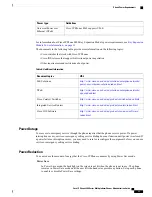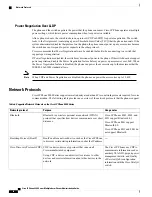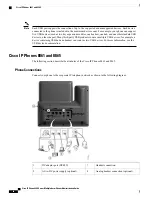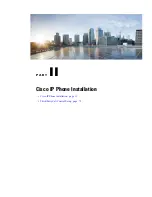
Usage notes
Purpose
Network protocol
SDP capabilities, such as codec
types, DTMF detection, and
comfort noise, are normally
configured on a global basis by
Cisco Unified Communications
Manager or Media Gateway in
operation. Some SIP endpoints
may allow configuration of these
parameters on the endpoint itself.
SDP is the portion of the SIP protocol that determines which
parameters are available during a connection between two
endpoints. Conferences are established by using only the SDP
capabilities that all endpoints in the conference support.
Session Description Protocol
(SDP)
SDP capabilities, such as codec
types, DTMF detection, and
comfort noise, are normally
configured on a global basis by
Third-Party Call Control System
or Media Gateway in operation.
Some SIP endpoints may allow
configuration of these parameters
on the endpoint itself.
SDP is the portion of the SIP protocol that determines which
parameters are available during a connection between two
endpoints. Conferences are established by using only the SDP
capabilities that all endpoints in the conference support.
Session Description Protocol
(SDP)
Like other VoIP protocols, SIP
addresses the functions of signaling
and session management within a
packet telephony network.
Signaling allows transportation of
call information across network
boundaries. Session management
provides the ability to control the
attributes of an end-to-end call.
Cisco IP Phones support the SIP
protocol when the phones are
operating in IPv6-only, IPv4-only,
or in both IPv4 and IPv6.
SIP is the Internet Engineering Task Force (IETF) standard
for multimedia conferencing over IP. SIP is an ASCII-based
application-layer control protocol (defined in RFC 3261) that
can be used to establish, maintain, and terminate calls between
two or more endpoints.
Session Initiation Protocol (SIP)
Cisco IP Phones use TCP to
connect to Third-Party Call Control
system and to access XML
services.
TCP is a connection-oriented transport protocol.
Transmission Control Protocol
(TCP)
Upon security implementation,
Cisco IP Phones use the TLS
protocol when securely registering
with Third-Party Call Control
system.
TLS is a standard protocol for securing and authenticating
communications.
Transport Layer Security (TLS)
TFTP requires a TFTP server in
your network that the DHCP server
can automatically identify.
TFTP allows you to transfer files over the network.
On the Cisco IP Phone, TFTP enables you to obtain a
configuration file specific to the phone type.
Trivial File Transfer Protocol
(TFTP)
Cisco IP Phone 8800 Series Multiplatform Phones Administration Guide
17
Network Protocols
Summary of Contents for 8851
Page 23: ...P A R T I About the Cisco IP Phone Technical Details page 9 Cisco IP Phone Hardware page 21 ...
Page 24: ......
Page 36: ...Cisco IP Phone 8800 Series Multiplatform Phones Administration Guide 20 USB Port Information ...
Page 48: ......
Page 98: ......
Page 136: ......
Page 168: ...Cisco IP Phone 8800 Series Multiplatform Phones Administration Guide 152 XML Services ...
Page 204: ...Cisco IP Phone 8800 Series Multiplatform Phones Administration Guide 188 Capture Packets ...
Page 210: ......















































